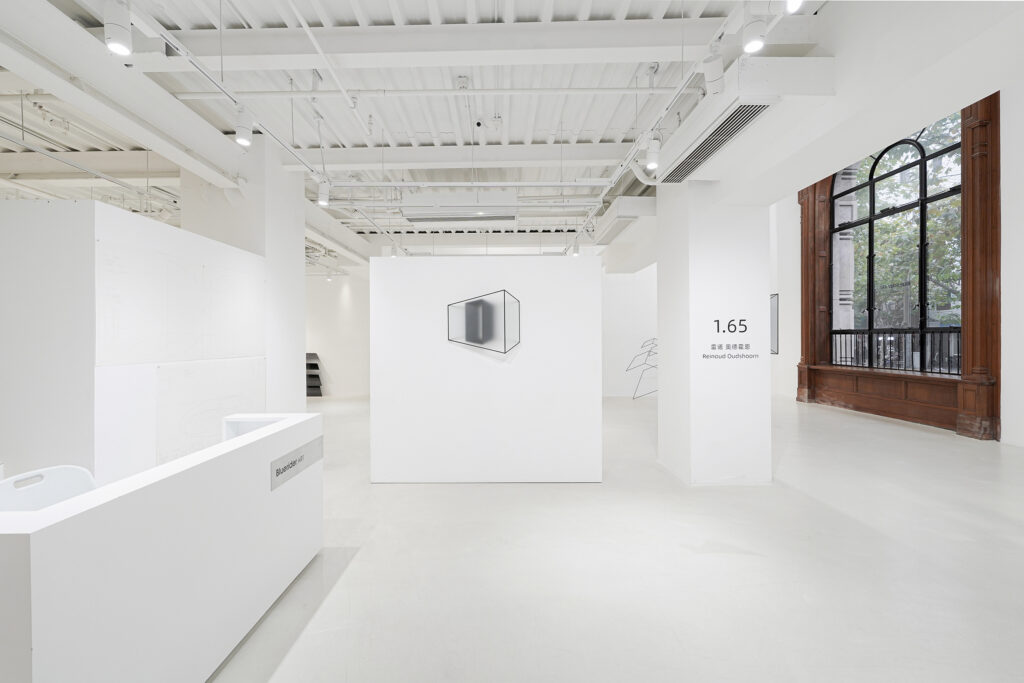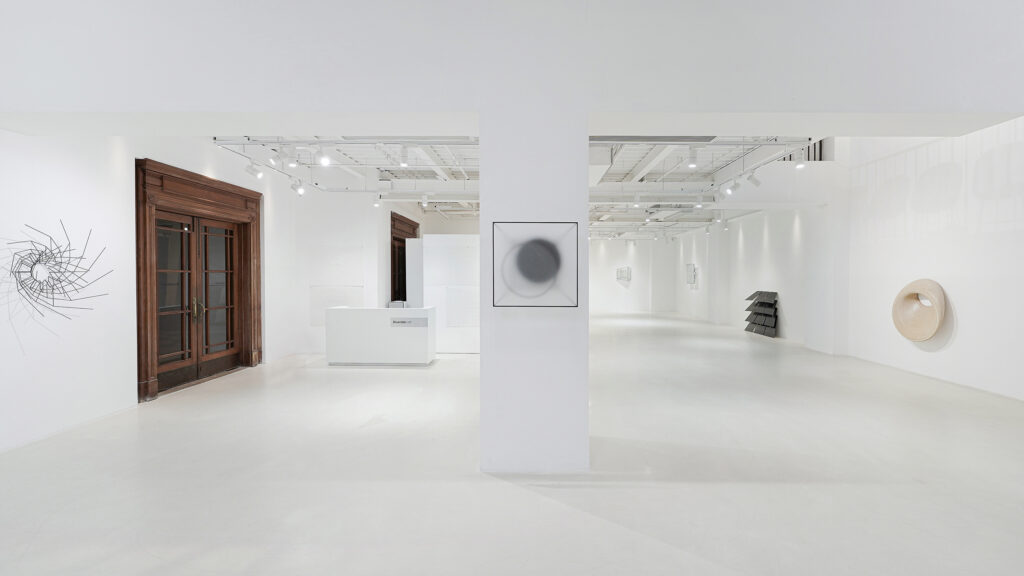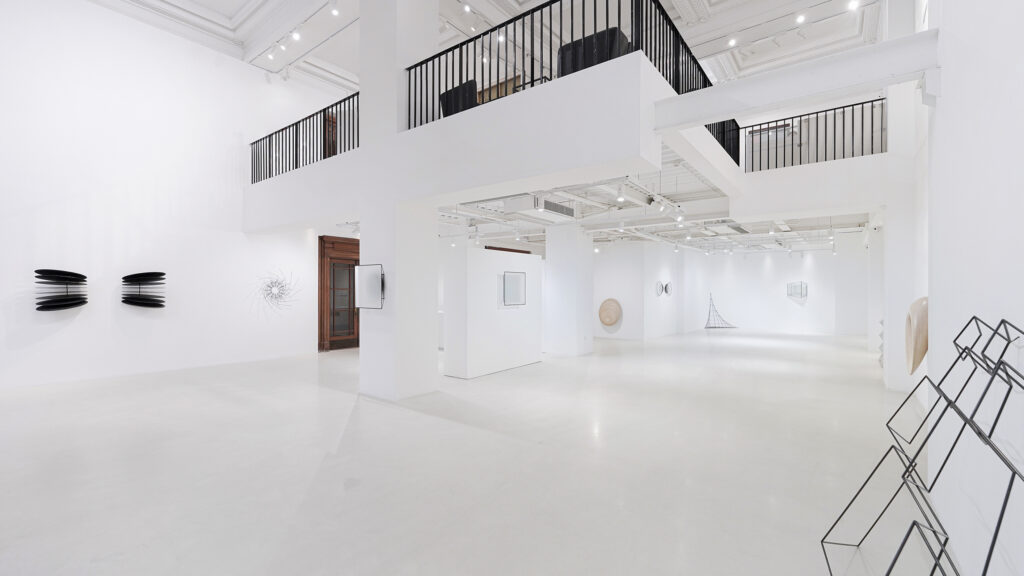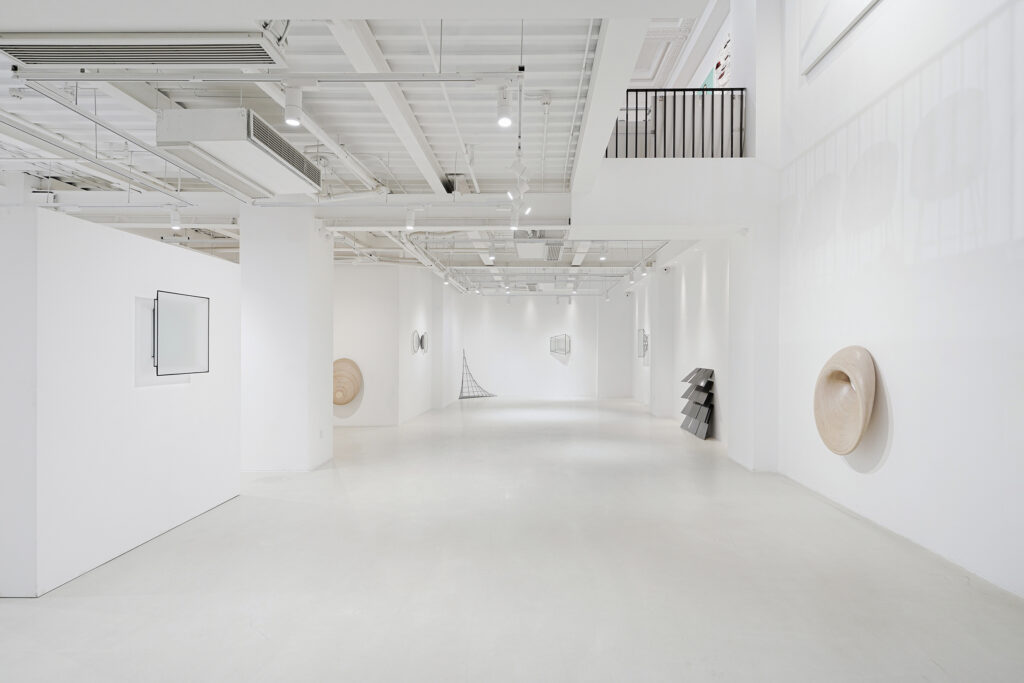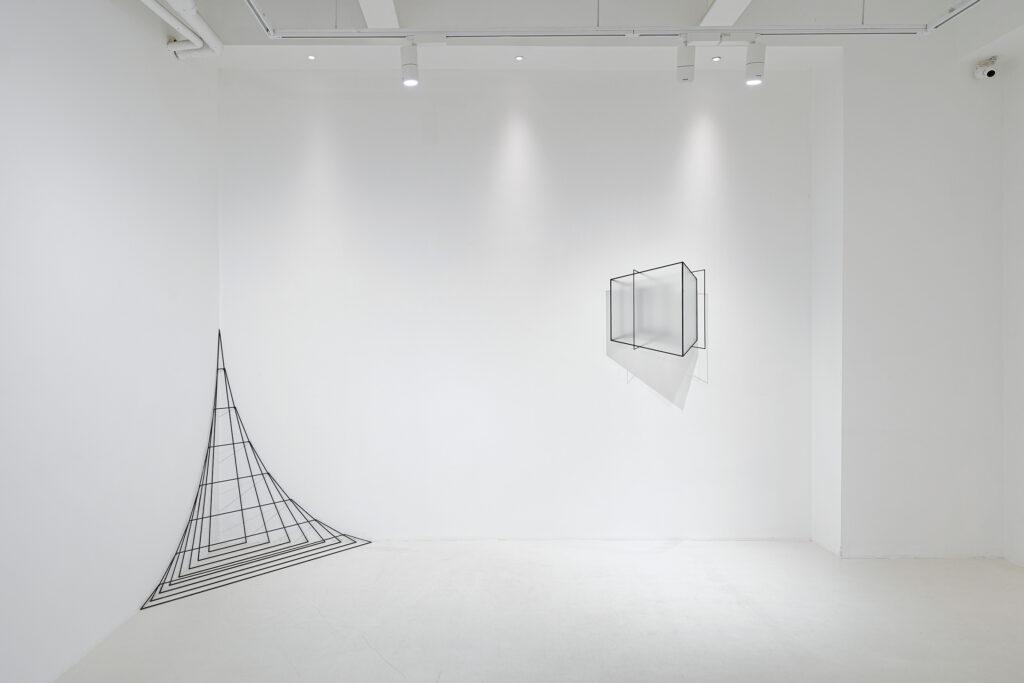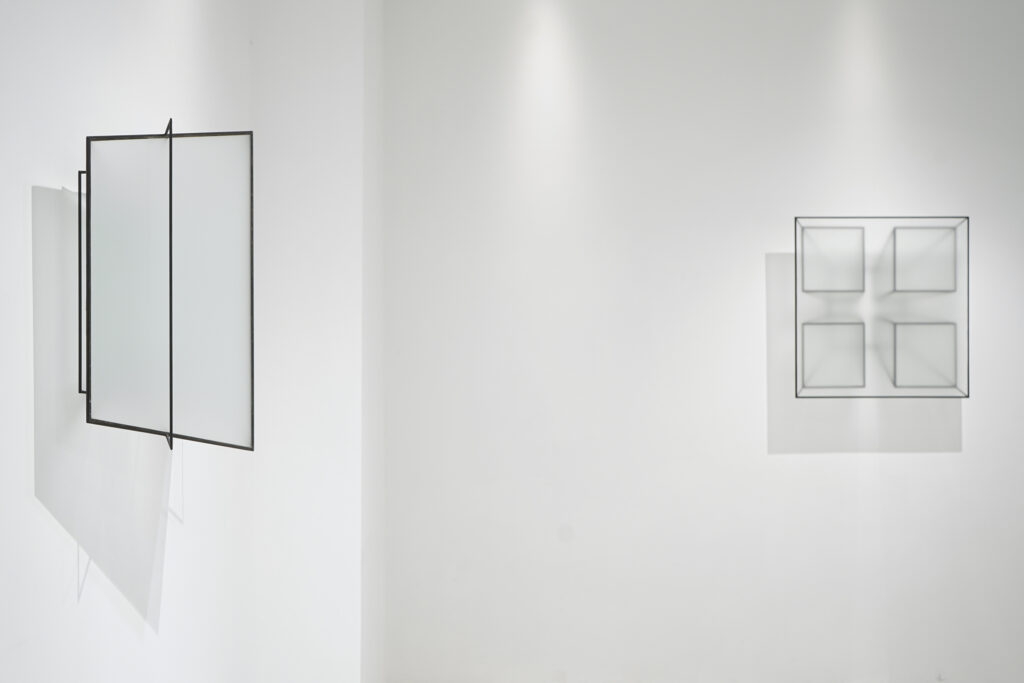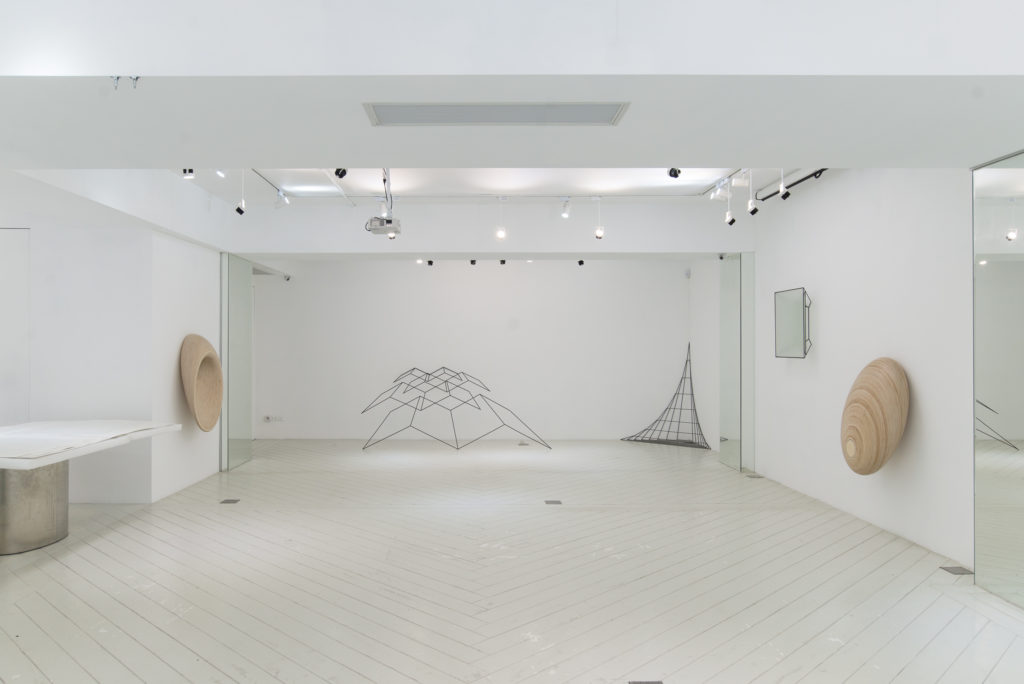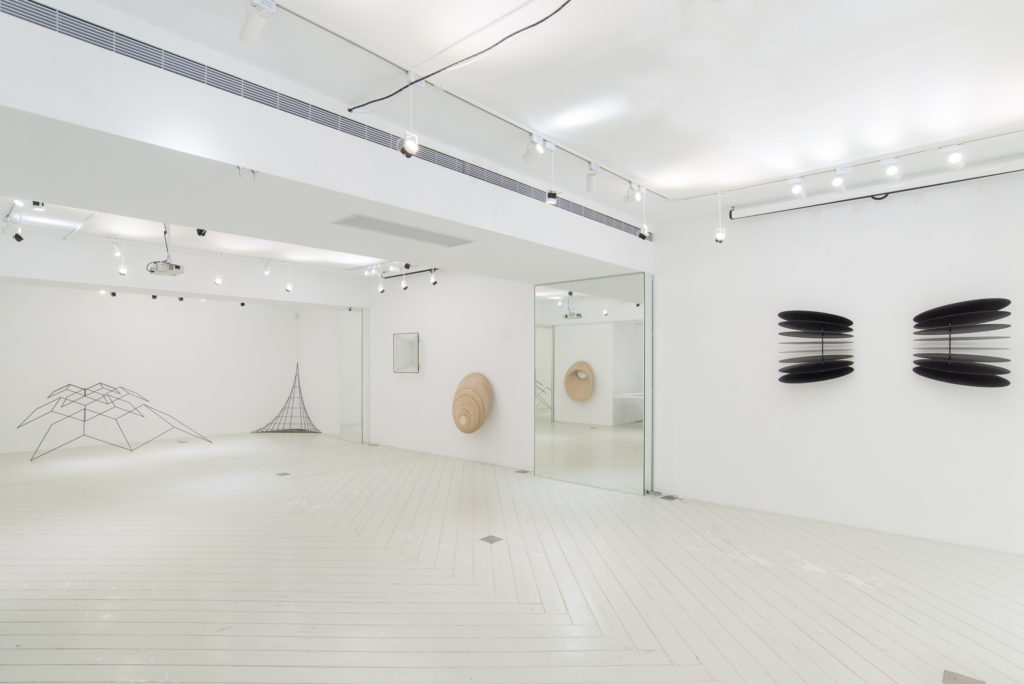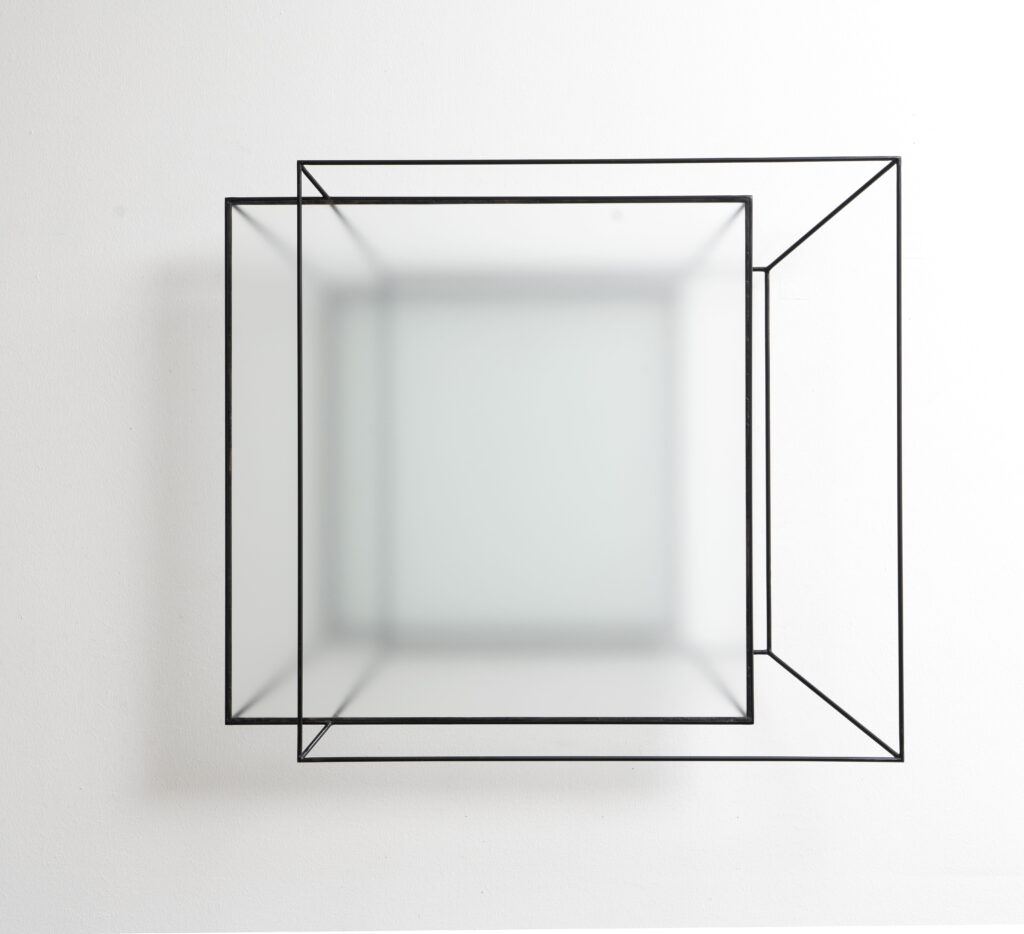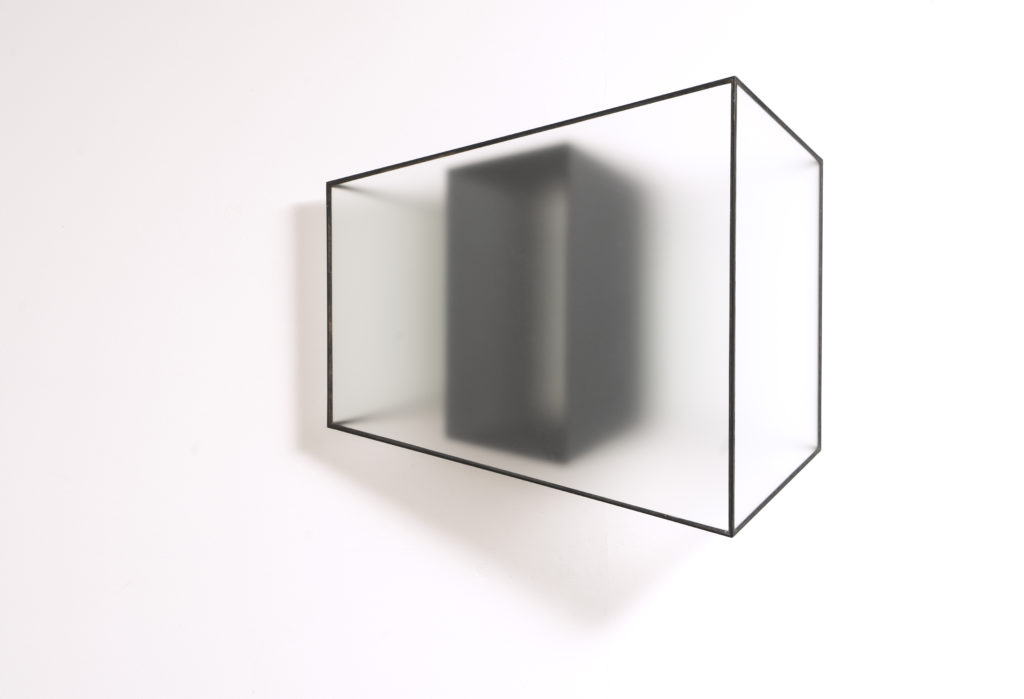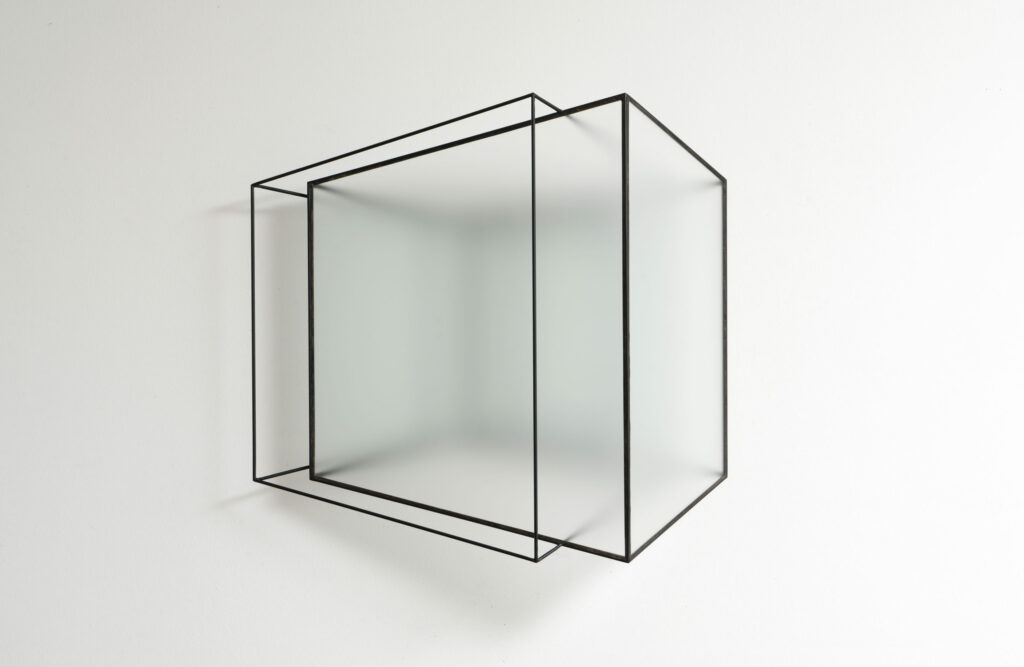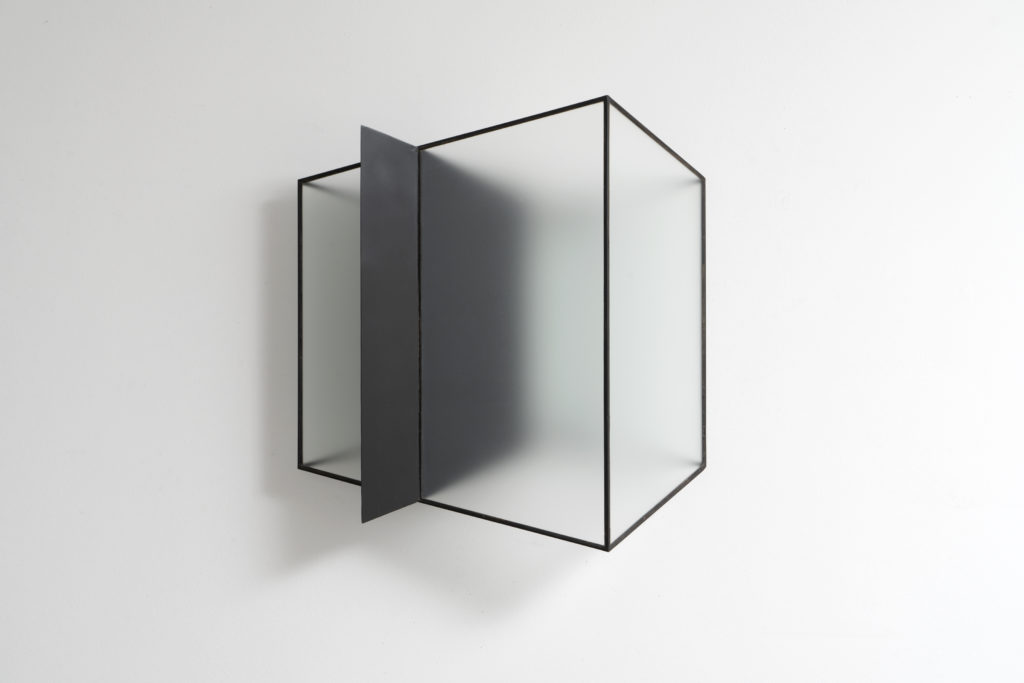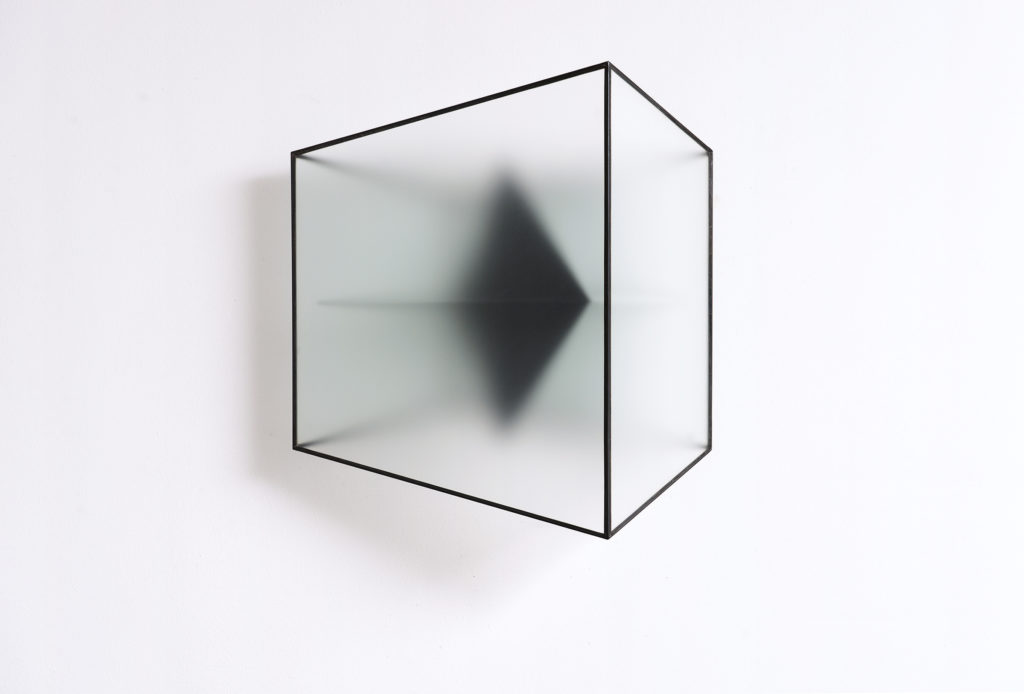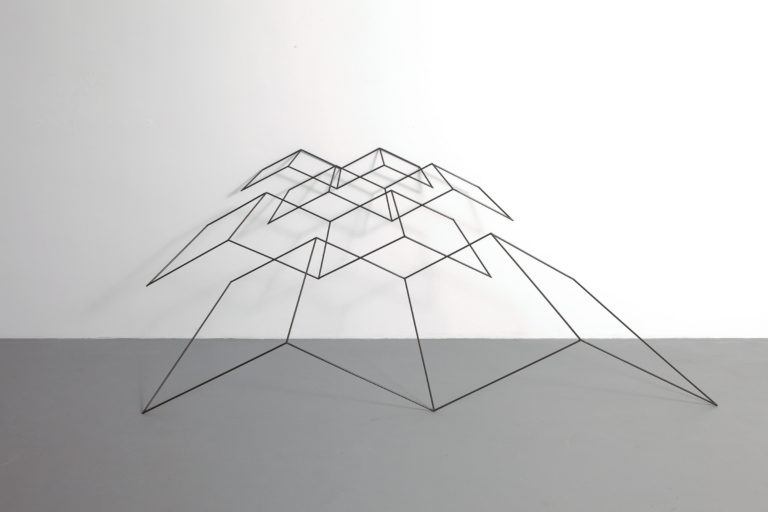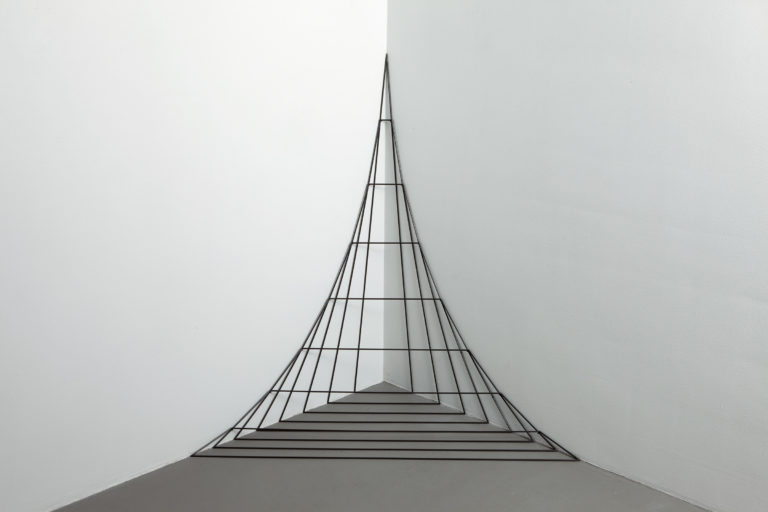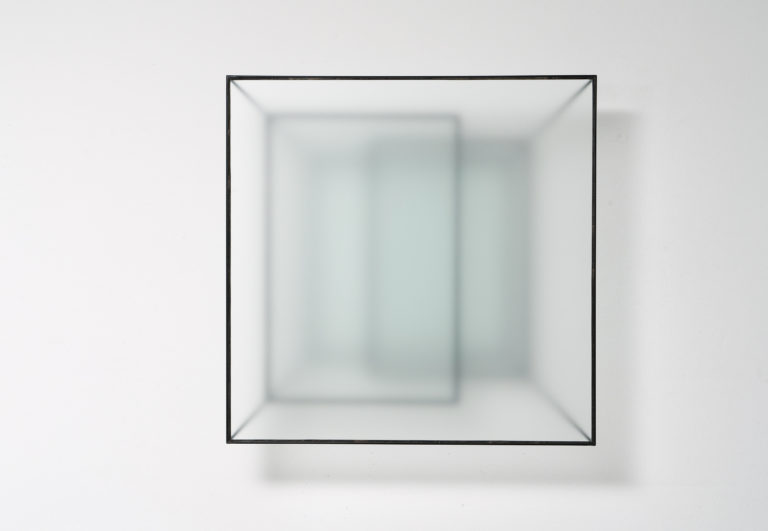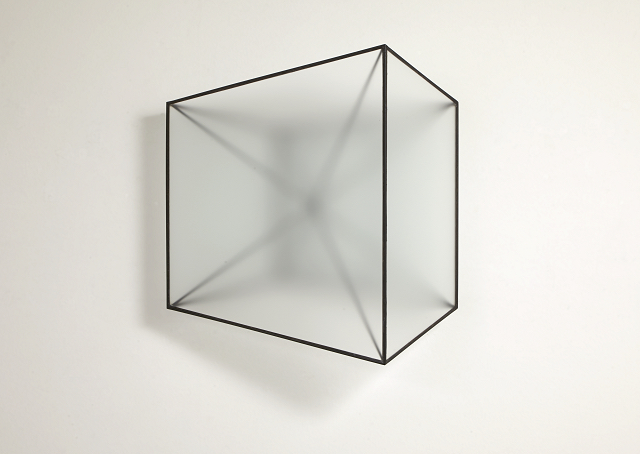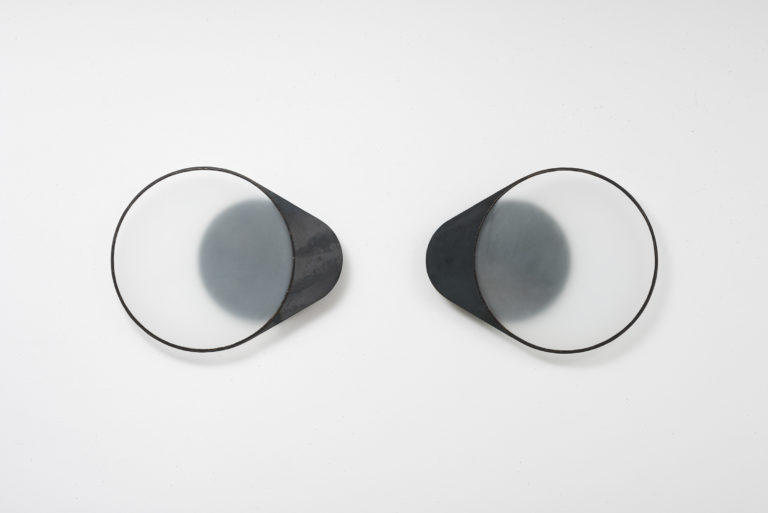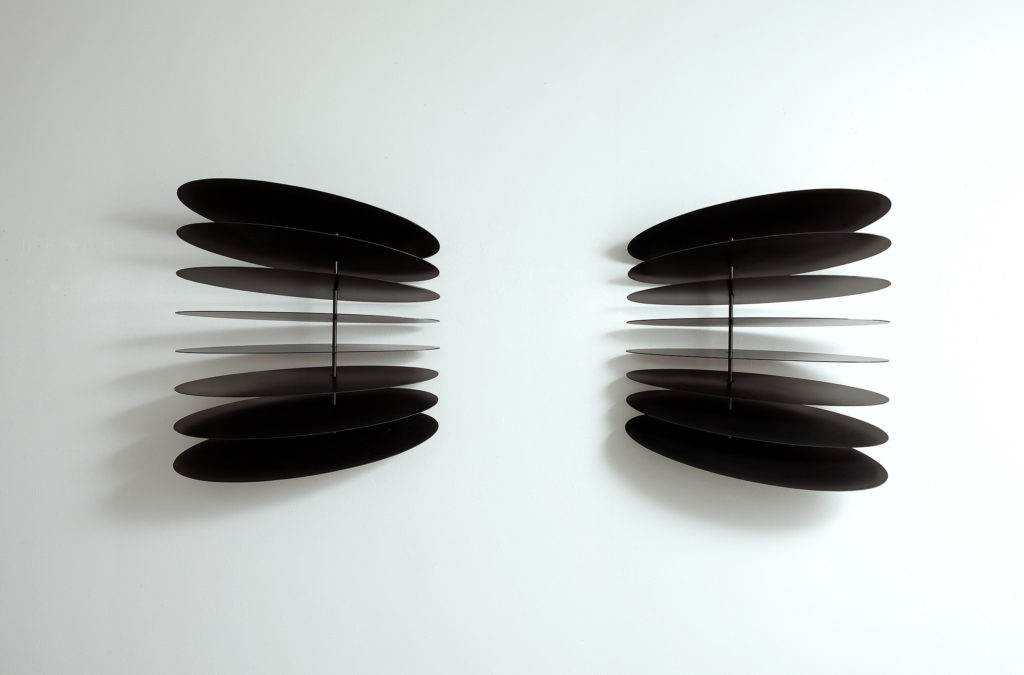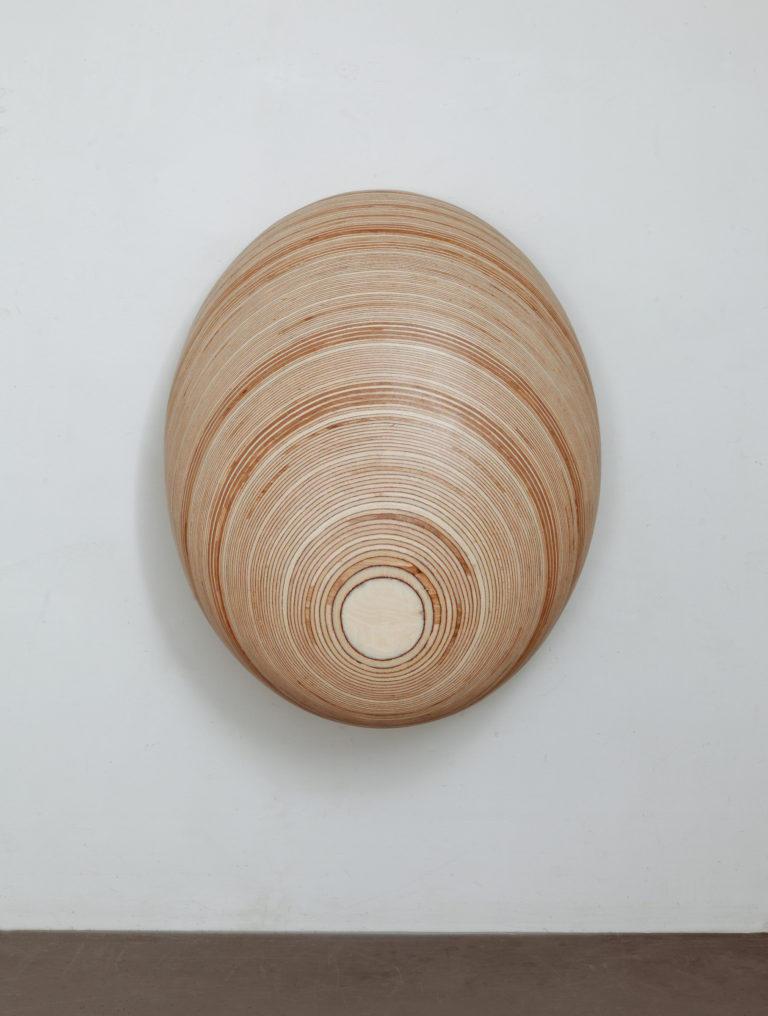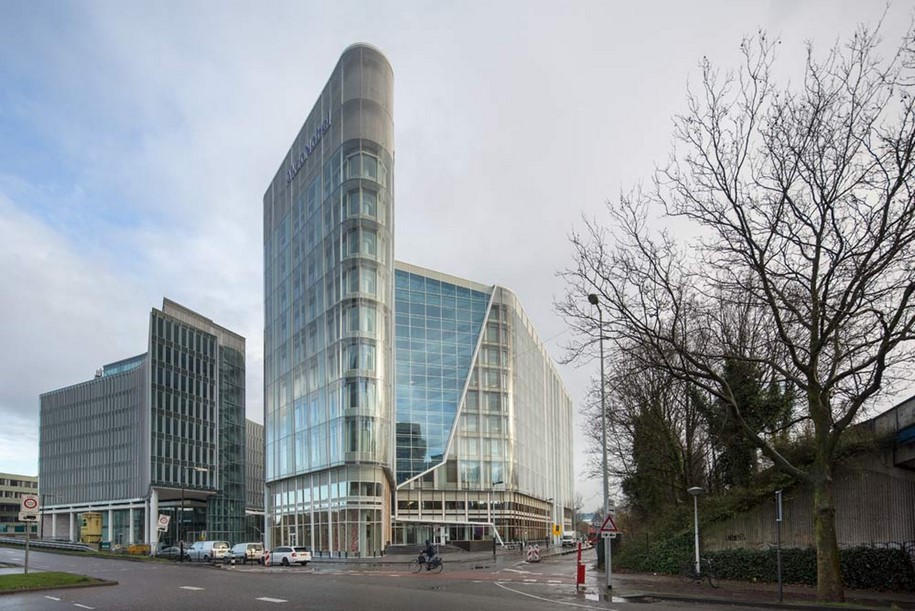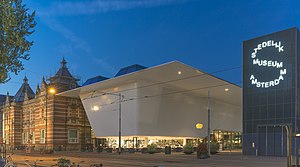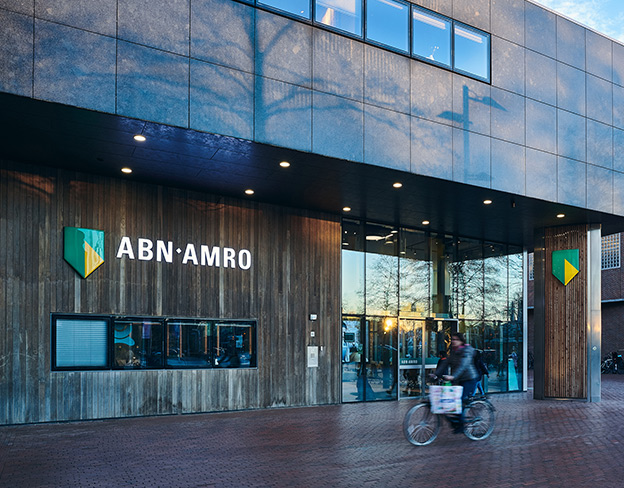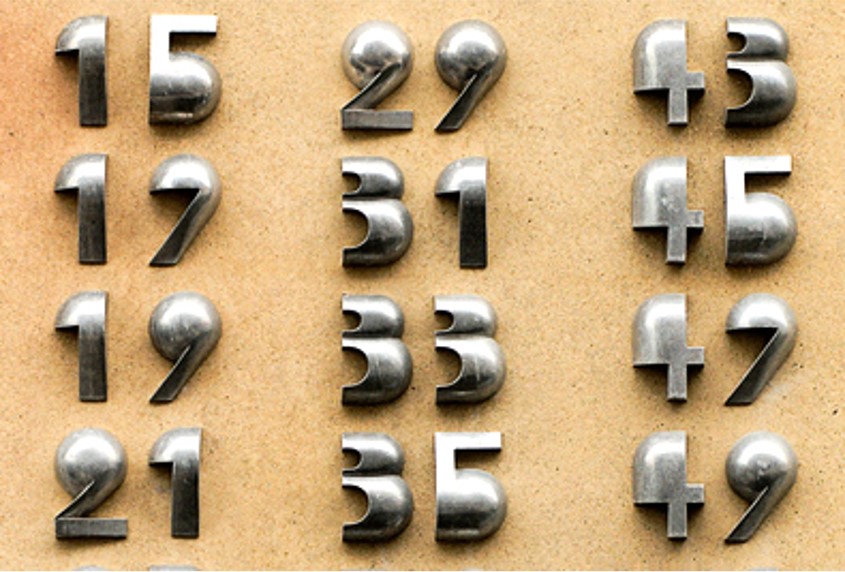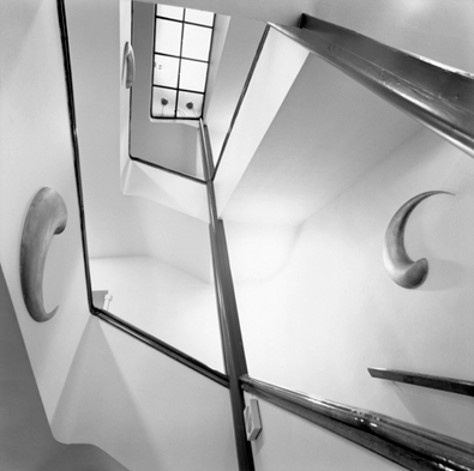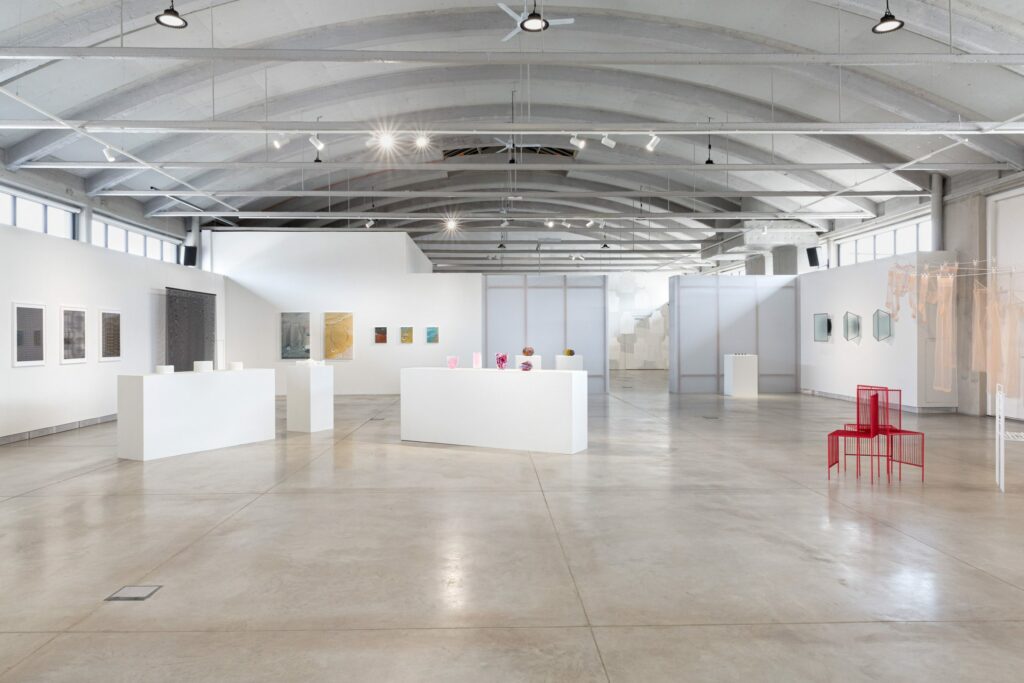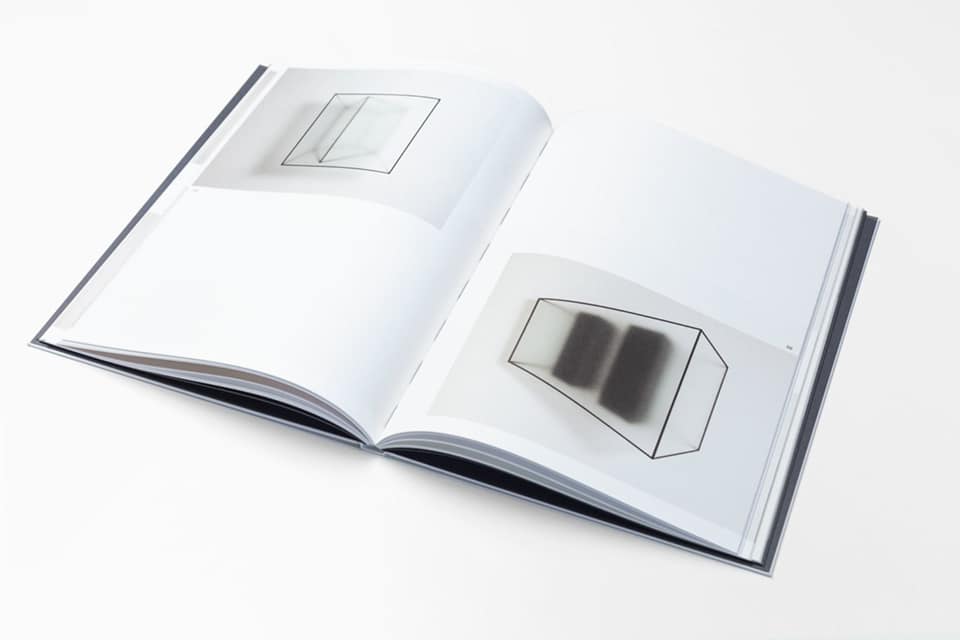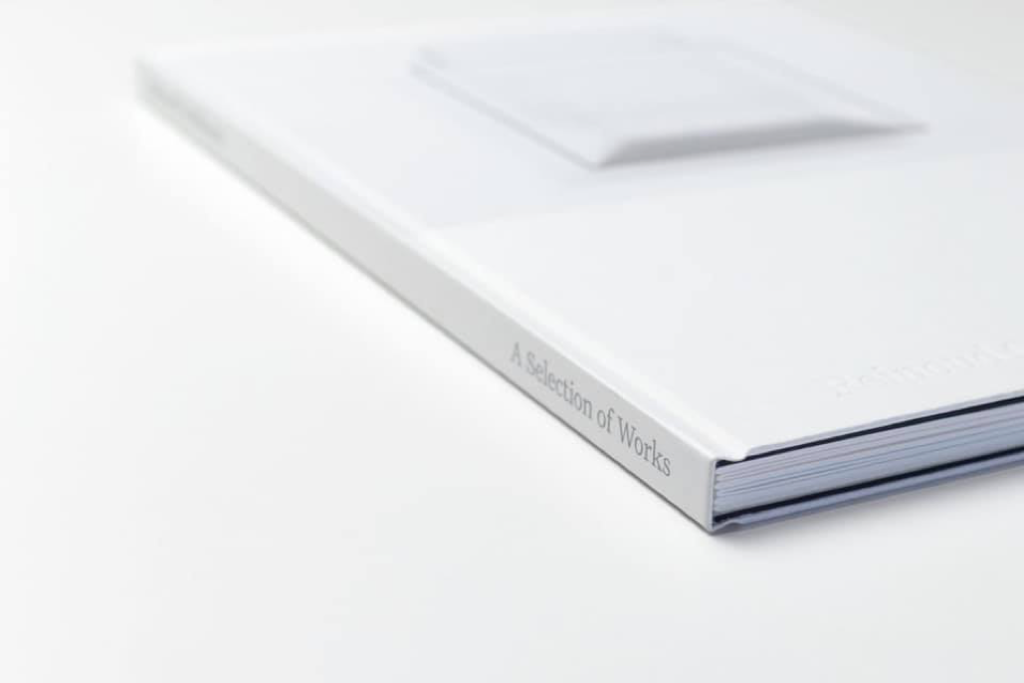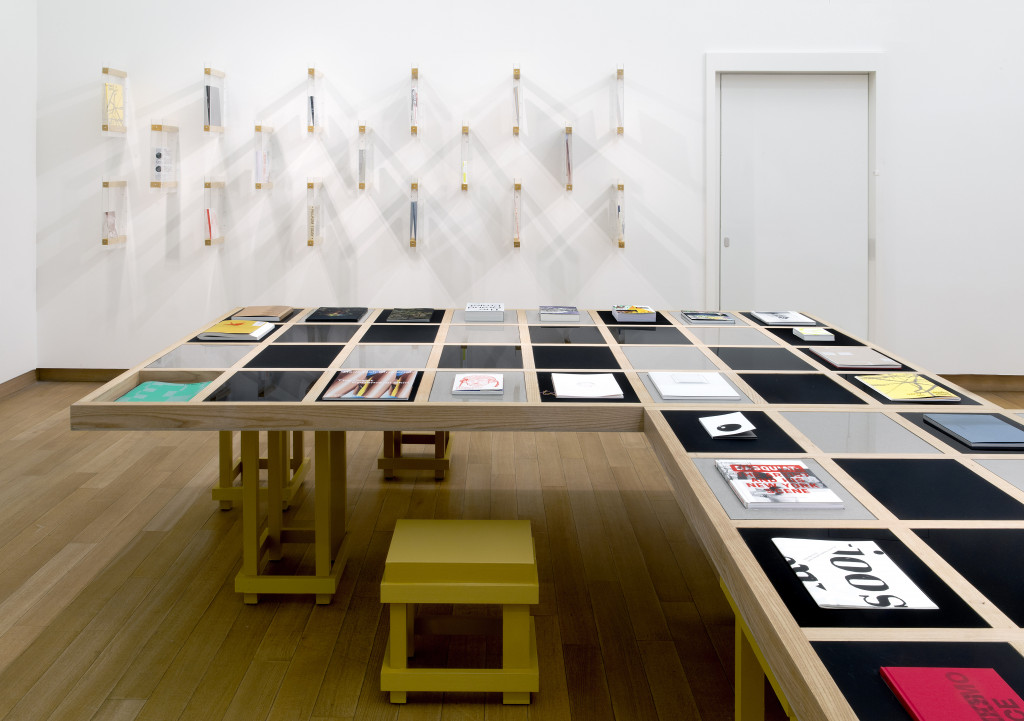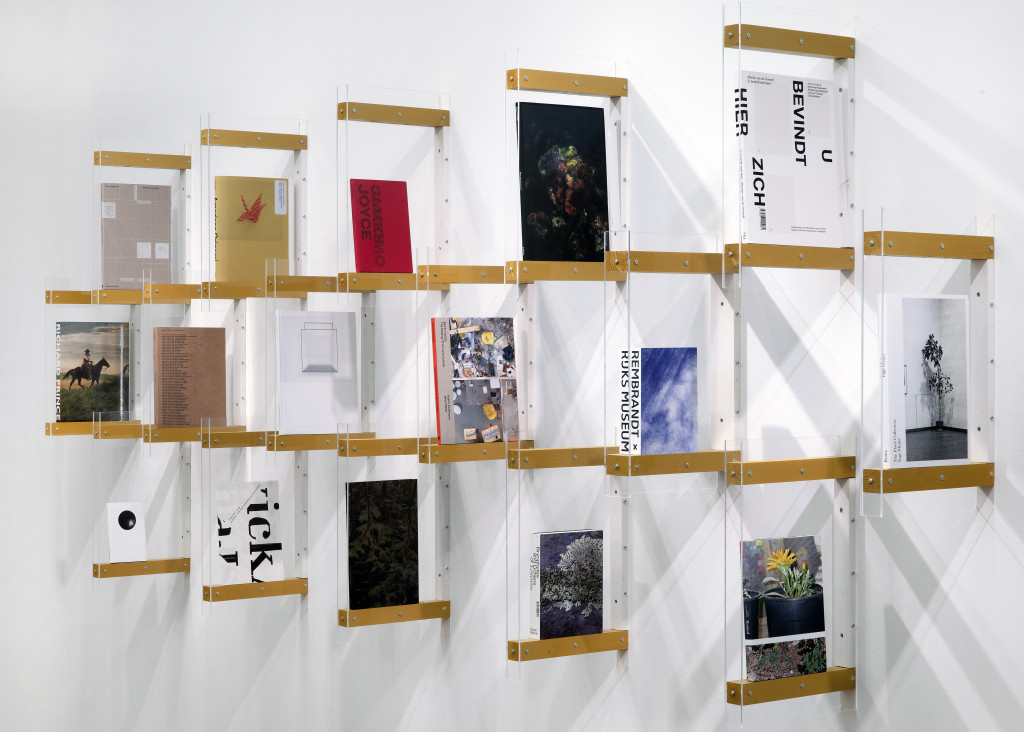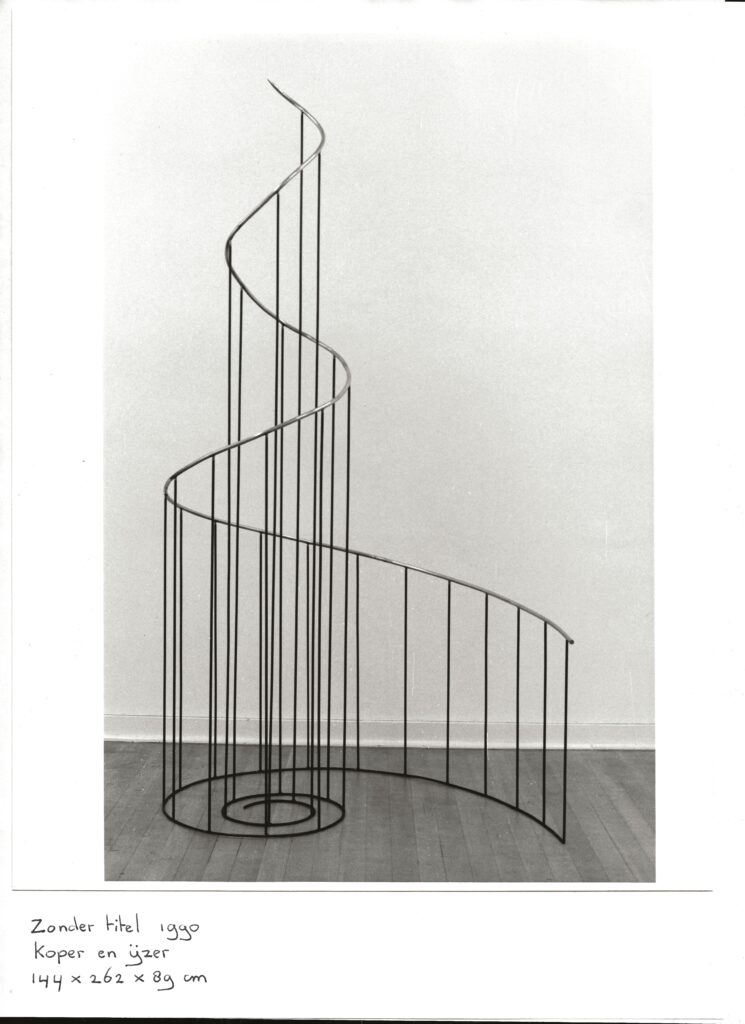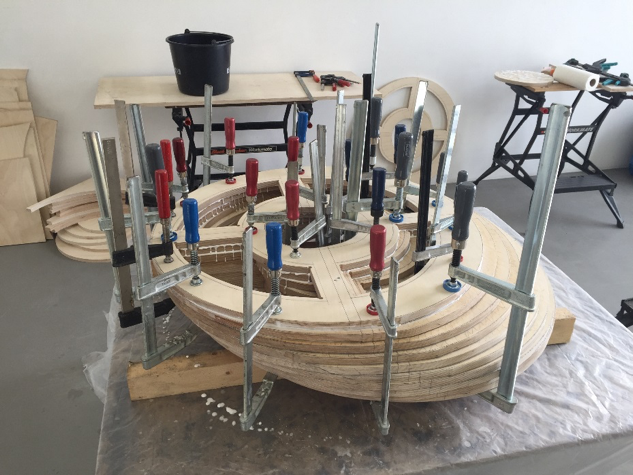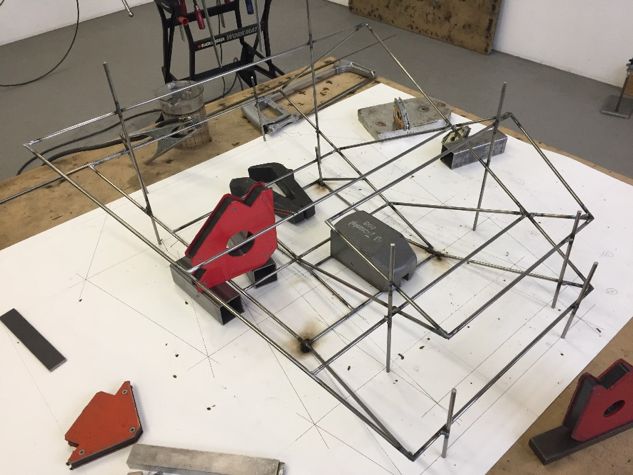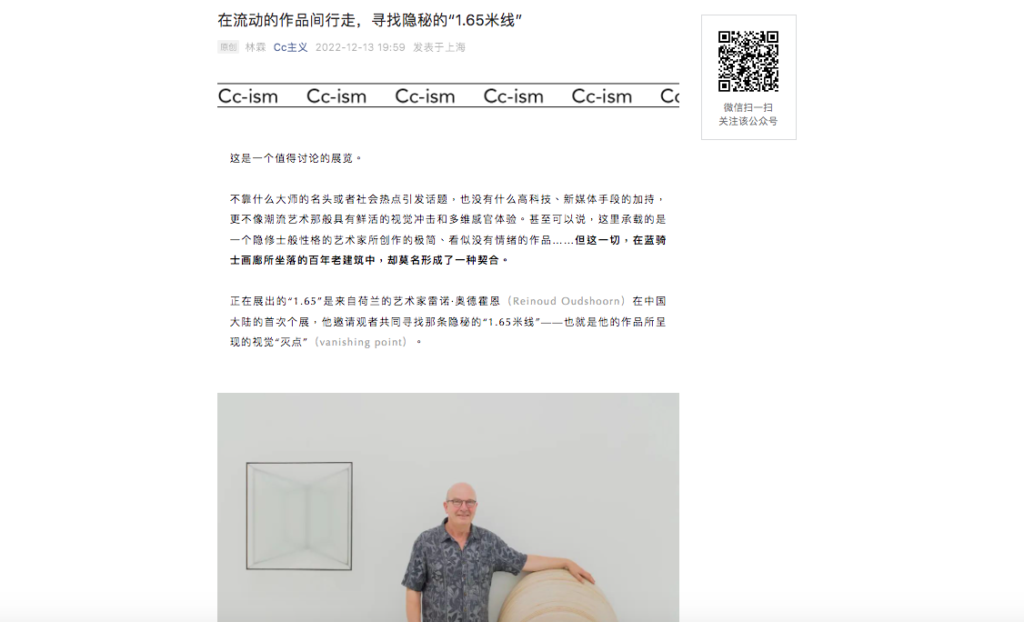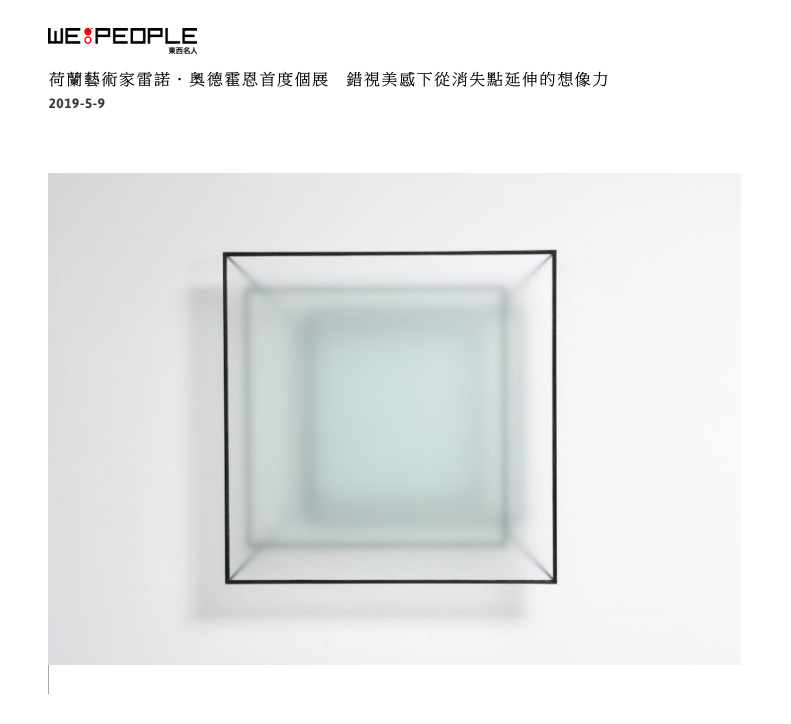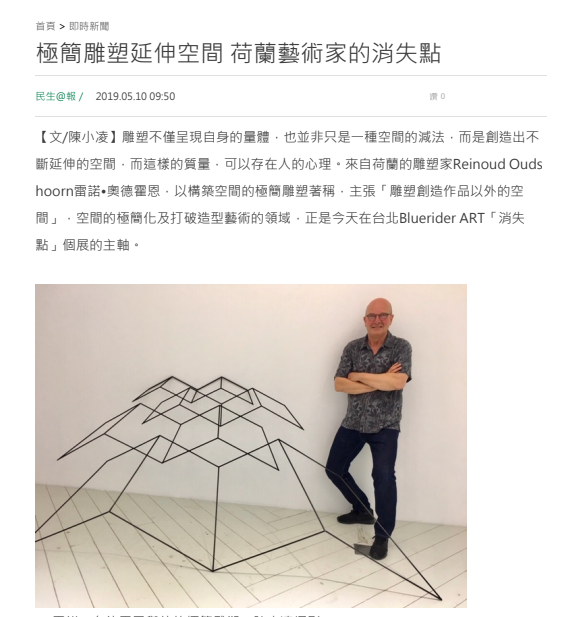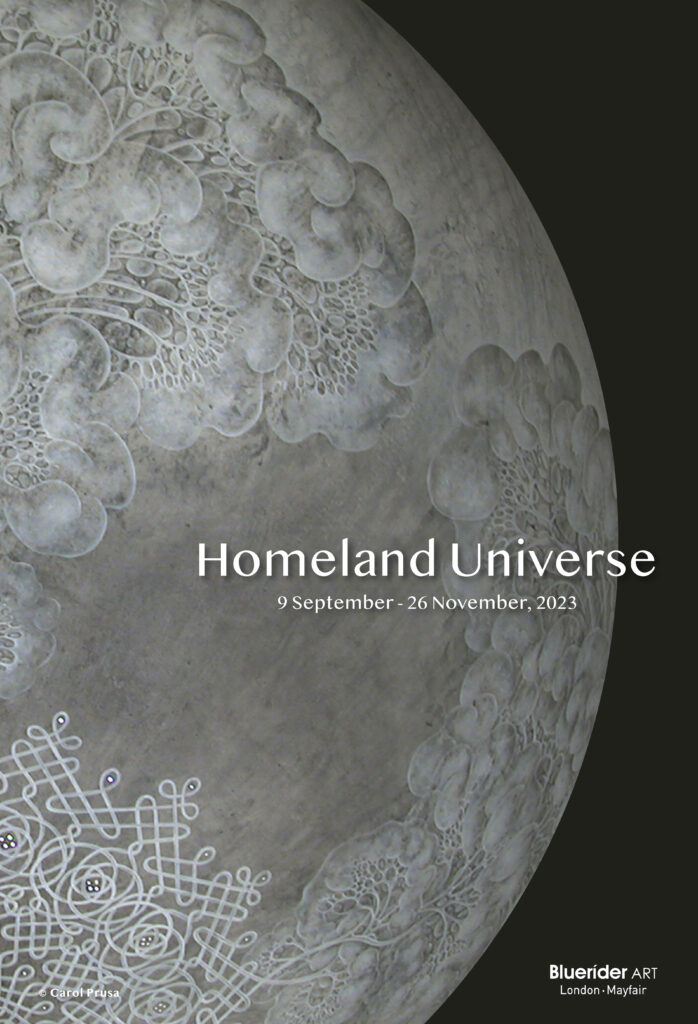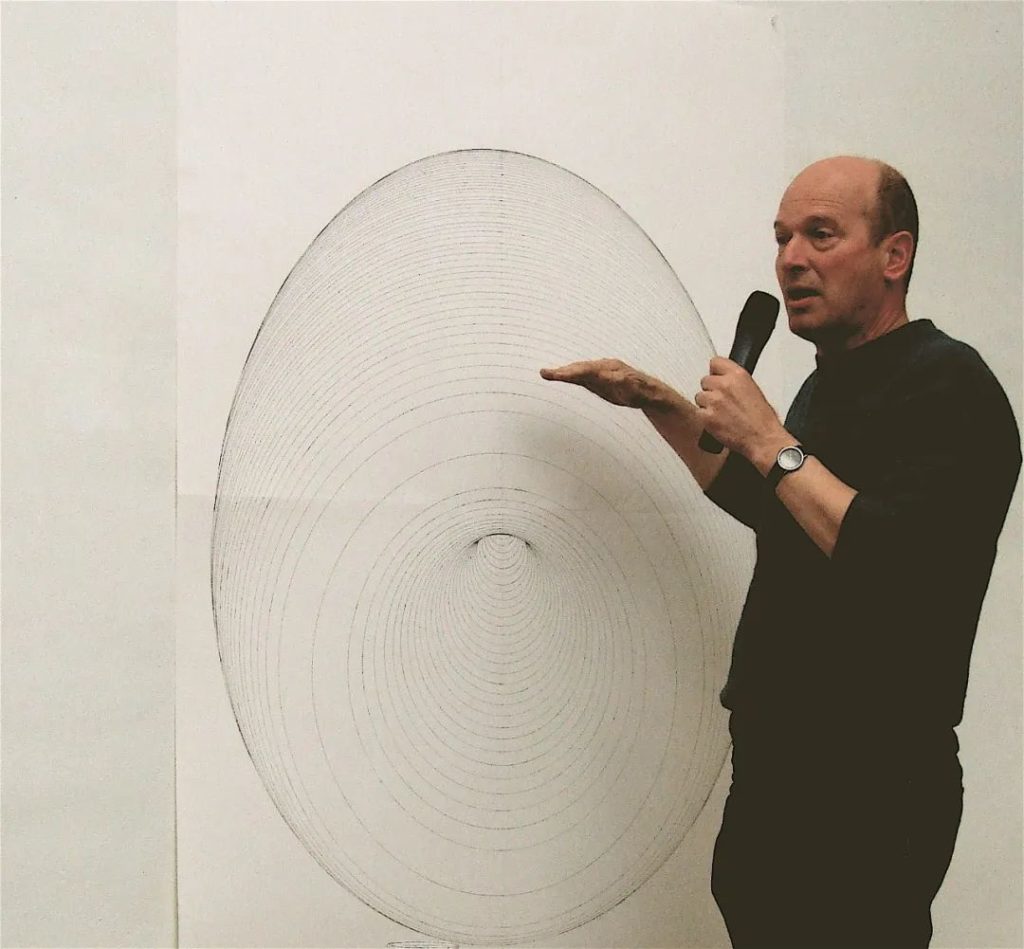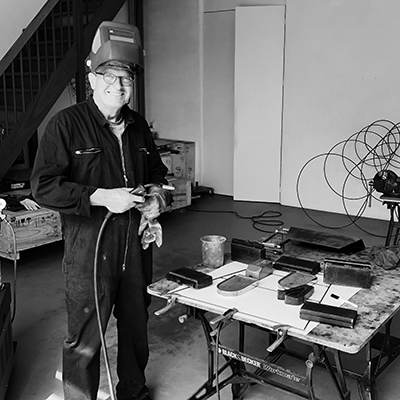

(Netherland, b. 1953)
Reinoud Oudshoorn lives and works in Amsterdam. Oudshoorn is known for his minimal sculpture by creating a bridge between the spatial illusion of a flat surface and the concrete reality of a physical object through the language of drawing and sculpture. He has held numerous solo and group exhibitions and his works entered important international collections including Stedelijk Musuem Amsterdam, AkzoNobel Art Foundation, ABN AMRO and Sammlung Schroth.
Participating in the 8th Tallinn Applied Art Triennale "Translucency" at Kai Art Center in Estonia in 2021
Stedelijk Museum Amsterdam
With exact mathematical calculation, Oudshoorn draws the perspective of the shape he would create, transforming the work from lines to planes, then from planes to a space according to the distance and the angles of viewing. Ousdhoorn’s sculptures are often made with iron and frosted glass, the latter a symbol of the contemplative, metaphysical and mysterious, atmospherically reminiscent of the muffled silence of mist, and tying in with the artist’s wish to transport a visual image into a space of one’s own imagination.
Oudshoorn’s inspiration for his sculptures originates from impressions of the world the artist experiences. This can be imagery drawn from nature or architectural shapes, and phenomena like the mist characteristic for his homeland. Abstracted into surfaces and structures, they are transformed into new objects that reveal contemplative and even mysterious qualities. This link between nature and infinity refers to influential artistic movements such as the simplified compositions of the De Stijl with its clear forms or to the atmospheric light of Dutch landscape painting. The play with perception and dissolution of forms relates Oudshoorn’s sculptures to works like the condensation cubes by Hans Haake from the early 60s or Anthony Gormley’s cloud chamber Blind Light.

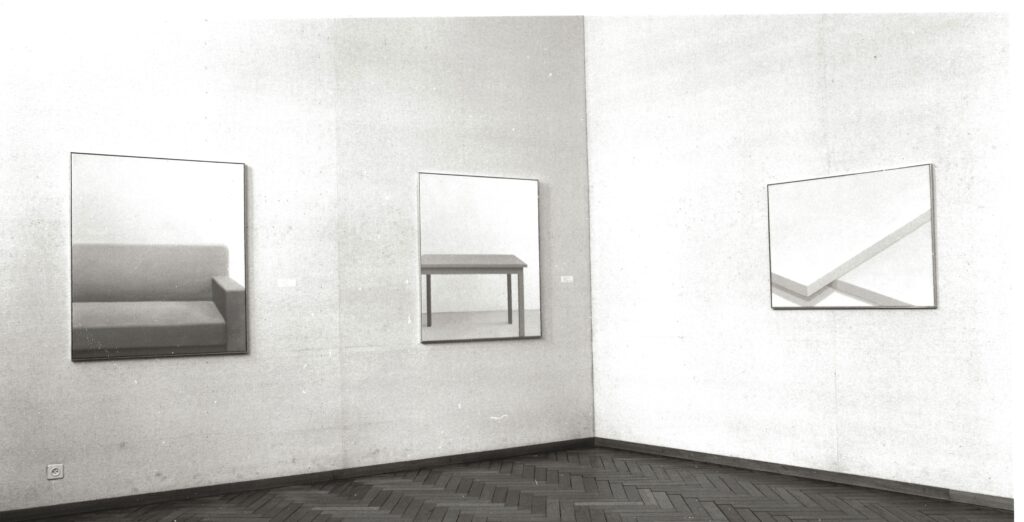
作品於阿姆斯特丹美術館(Stedelijk Museum in Amsterdam )展出 

Oudshoorn’s page in the catalogue, the paintings are from 1973 – 1975
an early work from 1990, A-90, lead on wood 180 x 84 x 84 cm
an early work from 1990, copper and steel 144 x 262 x 89 cm.



Reinoud Oudshoorn| G-21|64x64x22cm| Steel and frosted glass 

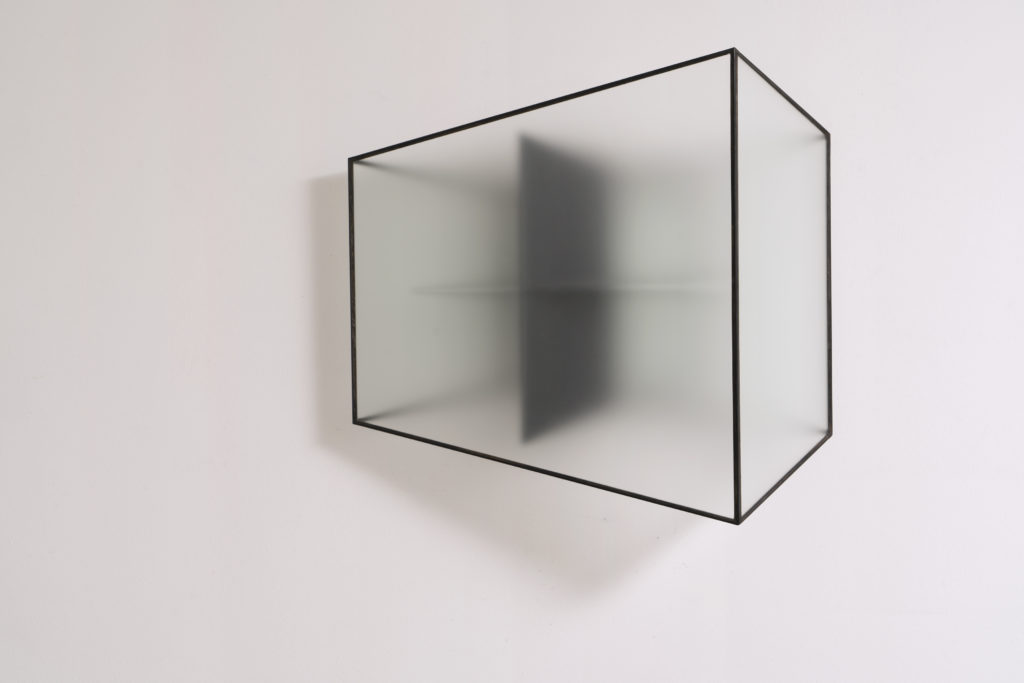
Q-20| 64x70x24cm|Steel and frosted glass
Oudshoorn's first solo show "Vanishing point" at Bluerider ART revolves around the concept of space and spatial illusion that he had been exploring since long. Space that becomes the concrete reality of a three-dimensional, but also spaces that lie in between the shapes and materials visible; areas that cannot be captured or confined and which remain hidden or obscured. "A sculpture must generate more space than it consumes", stated by Oudshoorn. With limited material and surface, the artist seeks to provide viewers the experience of the totality of space through a relatively small object. He explores the gap between finitude of physical subjects and infinity of immaterial subjects, suggesting an endlessness in the space that surrounds us, an infinity of mind and sphere.
Reinoud Oudshoorn's creative manuscript
Selected Solo Exhibitions
2020 Fragmented Truth (with Alice Quaresma), Patrick Heide Contemporary Art, London
2019 Vanishing Point,Bluerider ART, Taipei, Taiwan
2017 Dimensions of three, Allouche Gallery, New York, US
2017 Recent Sculptures, Patrick Heide Art Company, London, UK
2015 Ramakers Gallery, The Hague, The Netherlands
2013 Recent Sculptures, Patrick Heide Art Company, London, UK
2012 Dimensions, Gallery Skape, Seoul, South Korea
2011 Wetering Gallery, Amsterdam, The Netherlands
2010 Poetic reality in space, Gallery Skape, Seoul, South Korea
2009 Wetering Gallery, Amsterdam, The Netherlands
2008 Art Amsterdam, Wetering Gallery, Amsterdam, The Netherlands
2008 Wetering Gallery, Amsterdam, The Netherlands
2005 Wetering Gallery, Amsterdam, The Netherlands
2003 Wetering Gallery, Amsterdam, The Netherlands
2000 Wetering Gallery, Amsterdam, The Netherlands
1998 Wetering Gallery, Amsterdam, The Netherlands
1996 Wetering Gallery, Amsterdam, The Netherlands
1995 Wetering Gallery, Amsterdam, The Netherlands
1994 Path Gallery, Aalst, Belgium
1993 Wetering Gallery, Amsterdam, The Netherlands
1992 Wetering Gallery, Amsterdam, The Netherlands
1991 Path Gallery, Aalst, Belgium
1990 Wetering Gallery, Amsterdam, The Netherlands
1988 Waalkens Gallery, Finsterwolde, The Netherlands
1987 Wetering Gallery, Amsterdam, The Netherlands
1985 Wetering Gallery, Amsterdam, The Netherlands
1983 Wetering Gallery, Amsterdam, The Netherlands
1981 Wetering Gallery, Amsterdam, The Netherlands
1979 Museum Fodor, Amsterdam, The Netherlands
1978 Waalkens Gallery, Finsterwolde, The Netherlands
Selected Group Exhibition
2022 The Blue Danube, Bluerider ART ,Shanghai , China
2021 Mental Space,Bluerider ART ,Taipei. , Taiwan
2020 For the Love of Art Part 1and 2, Gallery Ramakers, The Hague
2020 Gallery Ramakers at Art Rotterdam.
2019 Uit het atelier, Gallery Ramakers, The Hague, The Netherlands
2018 3D “Schrift am Bau”, Museum für Gestaltung, Zürich, Switzerland
2018 Volta NY, Allouche Gallery, New York, USA
2017 Machinerie, Proviciehuis, Haarlem, The Netherlands
2017 Art Rotterdam, Ramakers Gallery, The Netherlands
2017 Art Geneva, Patrick Heide, Geneva, Switzerland
2016 PULSE Miami, Patrick Heide, Miami, USA
2016 Shall I compare thee to a summer’s day, Ramakers Gallery, The Hague, The
Netherlands
2016 Grand opening new space” Gallery Allouche Gallery, New York, USA
2016 Volta Basel, Patrick Heide, Basel, Switzerland
2016 Konstruction Construction, Museum Sammlung Schroth, Soest, Germany
2016 Art Geneva, Patrick Heide, Geneva, Switzerland
2016 Licht en transparantie, Thomas Elshuis en Reinoud Oudshoorn, Nieuw
Dakota, Amsterdam, The Netherlands
2016 Ramakers Gallery, The Hague, The Netherlands
2015 Patrick Heide Gallery on the Miami Pulse, Miami, USA
2015 A call for drawing, Symposium, HKU, Utrecht, The Netherlands
2015 Volta Basel, Patrick Heide Gallery, Basel, Switzerland.
2014 PULSE Miami, Patrick Heide Gallery, Miami, USA
2014 Nanjing International Art Festival, Nanjing, China.
2014 Short-hand-made, Grindel 117, Hamburg. Germany.
2014 20 years anniversary, Ramakers Gallery, The Hague, The Netherlands
2014 Volta Basel, Patrick Heide Gallery, Basel, Switzerland.
2013 PULSE Miami, Patrick Heide Gallery, Miami, USA
2013 Hidden dimension, Gallery Skape, Seoul, South Korea.
2013 The last picture show, Wetering Gallery, Amsterdam, The Netherlands
2013 Hidden dimension, Gallery Skape, Seoul, South Korea
2013 Capriccio, JCA de KOK centre for contemporary art, The Hauge, The
Netherlands
2013 Reinoud Oudshoorn and Jérôme Touron, Ramakers Gallery, The Hauge, The
Netherlands
2012 PULSE Miami, Patrick Heide Gallery, Miami, USA
2012 Gallery Skape, Gallery Seoul Art Fair, Seoul, South Korea
2011 PULSE Miami, Patrick Heide Gallery, Miami, USA
2011 Permanent Exibition, Skape Gallery, Seoul, South Korea
2010 PULSE Miami, Patrick Heide Gallery, Miami USA
2010 Space A 2010, Gallery Space, Seoul, South Korea
2008 Ten Feet De Vishal, Haarlem, The Netherlands
2007 De keuze van Lucassen Ramakers Gallery, The Hague
2006 Façade Arti et Amicitiae, Amsterdam, The Netherlands
2001 A Public Space 2001 Odyssey Arti et Amicitiae, Amsterdam, The Netherlands
1997 Nooit zag ik Awater zo nabij Oude Kerkje, Kortenhoef, The Netherlands
1997 One Line Drawing, Ubu Gallery, New York, USA
1996 The Dutch Connection Marshall Art Gallery, Memphis TN, USA
1996 Weatherview Norwich Gallery, Norwich, UK
1994 The Collection Stedelijk Museum, Amsterdam, The Netherlands
1994 De keuze van Betty van Garrel Wetering Gallery, Amsterdam, The
Netherlands
1993 Atelier Mémoire, Paris, France
1993 20 Years Wetering Gallery Wetering Gallery, Amsterdam, The Netherlands
1993 Kai,Sagaert et Oudshoorn Atelier Mémoire, Paris, France
1992 Le Génie de la Bastille Paris, France
1992 Gemeente Kunstaankopen 1991 Museum Fodor, Amsterdam, The Netherlands
1990 Liberations Jewish Historical Museum, Amsterdam, The Netherlands
1989 Kunstlijn Sculpture Route Zwolle-Emmen, The Netherlands
1989 AMRO Bank Collection, A Choice Stedelijk Museum, Amsterdam, The
Netherlands
1988 Spiel der Uberraschungen der Europaïschen Kunst des 20 Jahrhundert,
Bochholt, Germany
1986 KunstRai, Wetering Gallery, Amsterdam, The Netherlands
1984 De Kampanje, Den Helder, The Netherlands
1981 Felison op Beeckestijn, with Marlene Dumas, Velzen Zuid, The Netherlands
1979 Van Krimpen Gallery, Amsterdam, The Netherlands
1976 11 Painters, Stedelijk Museum, Amsterdam, The Netherlands
1975 Markt 17, Enschede, The Netherlands
1974 Rijksmuseum Twente, Enschede, The Netherlands
Collections
Akzo Nobel Art Foundation
Collection Stedelijk Museum, Amsterdam
ABN AMRO Art Collection
The Chadha Art Collection
Eleanore De Sole Collection
Joods historisch museum
University Medical Center Utrecht
Collection Sammlung Schroth, Germany
Selected Publications
2019 “Reinoud Oudshoorn” Book, monograph.
2018 Patrick Heide Contemparary Art “Ten Years”
2017 Collection “Sammlung Schroth (1981-2016)”, Stiftung Konzeptuelle Kunst.
2017 Safari Typo Amsterdam, by Bas Jacobs
2013 Den Haag Centraal, Culture, 12-04-2013 “Vernuftig spel met ruimte en kleur”
door Egbert van Faassen.
2012 Cat. Gallery Skape, Reinoud Oudshoorn,”Dimensions” by Wonseok Koh
[Curator Arko Art Center]
2012 ART in culture, Seoul, Korea “Reinoud Oudshoorn / Choi KI Seog”
by Gim Jonggil
2012 Sunday Magazine, Seoul Korea Gallery review, Reinoud Oudshoorn at
Gallery Skape.
2011 Space, Architecture and Art magazine, Nr 529. “Poetics of space” by
Yunkyong Kim
2010 Cat. Gallery Skape “Reinoud Oudshoorn, Poetic reality in space”
2009 Kunstbeeld “Reinoud Oudshoorn, Anna van Leeuwen [Wetering Galerie]”
2008 “Reinoud Oudshoorn” Book, monograph.
2008 Kunstbeeld “Wiskunde voor de verbeelding”, Hans Sizoo
2006 NRC Handelsblad “Tijdreis door het gebouw van Arti”, Machteld Leij
2003 Kunstbeeld “Reinoud Oudshoorn, Wetering Galerie”, Hans Sizoo
2003 Items “Harde cijfers”, MVE
2001 Cat. Amsterdams Fonds voor de Kunst “A Public Space 2001, Odyssey”,
Amsterdam
2000 Kunstbeeld “Reinoud Oudshoorn, Wetering Galerie”, Willem van Beek
2000 Het Nederlandse Kunstboek Richard Fernhout/ Colin Huizing, Waanders
Publishers b.v. Zwolle, NL
1998 NRC Handelsblad “Wetering Galerie” Janneke Wesseling
1997 Stichting Collage Kortenhoef “Nooit zag ik Awater zo van nabij”
1997 The New York Times, Art in Review “One-Line Drawing”, Roberta Smith
1996 Het Financieele Dagblad “Expositie zonder titel toont levende joodse cultuur”,
Marty Bax
1996 The Memphis Flyer, “Dutch Treat”, Nancy Muse, Memphis TN, USA
1996 Cat. Norwich Gallery “Weatherview”, Norwich, UK
1995 Het Parool “Moderne Kunst in joodse context”, Pietje Tegenbosch
1994 Cat. Info Mémoart “Spécial Trones des Artistes”, édité par Atelier Mémoire,
Paris
1992 Het Parool “Abstractie”, Jan Bart Klaster
1992 Cat. Quartier de la Bastille, ‘Le Genié de la Bastille’, Paris
1992 Cat. Gemeente Kunstaankopen 1991 “Amsterdam Koopt Kunst”, Museum
Fodor, Amsterdam
1990 Het Parool “Afgebakende ruimte voor herinneringen”, interview by Jan Bart
Klaster
1990 Cat. Joods Historisch Museum “Bevrijdingen”, Amsterdam
1989 Het Parool, kunstbijlage “De Prent van Reinoud Oudshoorn”
1989 Cat. Stichting Beeldenroute Overijssel “Kunstlijn”, beeldenroute
Zwolle-Emmen
1989 Cat. Stedelijk Museum Amsterdam “De AMRO Bank collectie, een keuze”
1988 Cat. Tentoonstellingsdienst Overijssel “Spel der Verrassingen, Europese Kunst
van de 20ste eeuw”
1985 Het Financieele Dagblad “Beeldtekens”, Walter Barten
1984 Cat. De Kampanje, Den Helder NL
1983 Het Parool “Lichtvoetige Kunstwerken”, Frans Duister
1981 Haarlems Dagblad “Oudshoorn en Dumas dwingen tot kijken”, Kunstredactie
1981 NRC Handelsblad, “Dumas/ Oudshoorn laten zich inspireren door vreemde
dieren”, Paul Groot
1981 Stichting Felison, “Felison op Beeckestijn”, Velzen-Zuid
1978 Nieuwsblad van het Noorden “Atmosferische verstilling in het werk van
Reinoud Oudshoorn”, Erik Beenker
1976 Het Financieele Dagblad “Tentoonstelling in het Stedelijk”, Mathilde Visser
1976 De Nieuwe Linie, “De inteelt van het Stedelijk Museum”, Jan Juffermans
1976 Cat. Stedelijk Museum Amsterdam “11 Painters”

 Tekst Hans Sizoo
Tekst Hans Sizoo


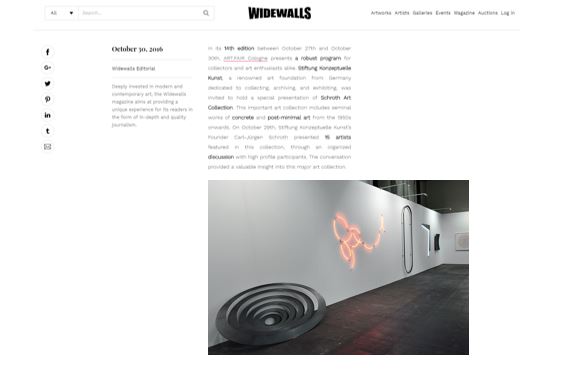 Wide Walls
Wide Walls
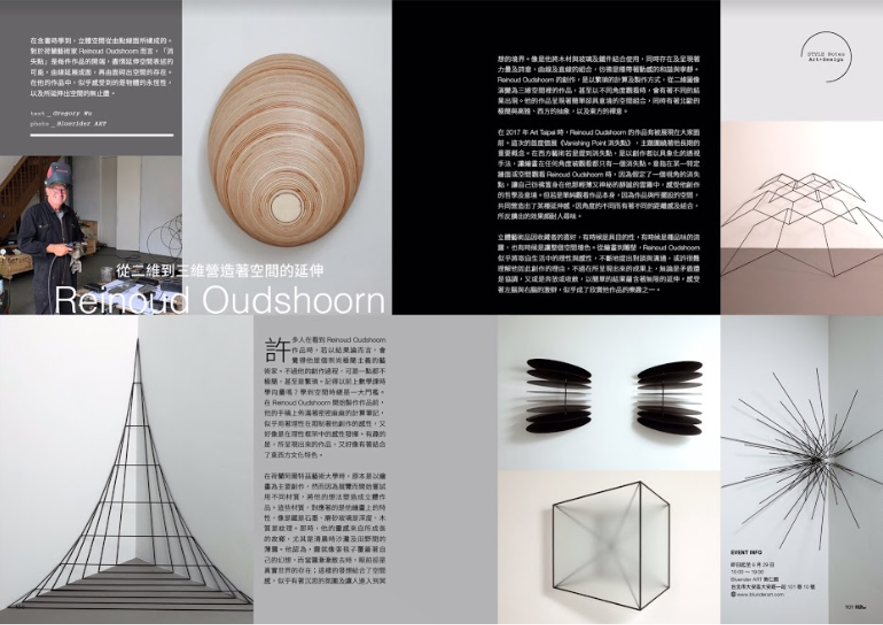 Style Master
Style Master
